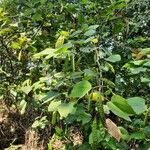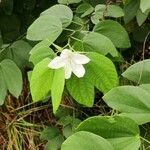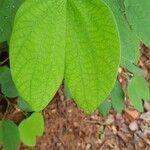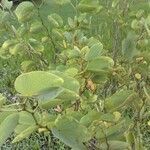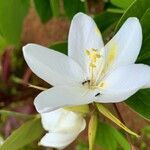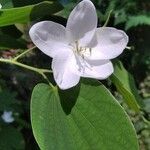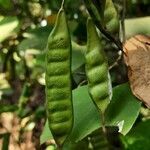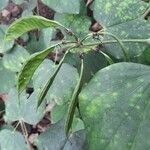Shrub up to 3 m high. Young branches greyish pubescent, later glabrous. Leaves: stipules linear, pubescent, c. 1 cm long, tardily caducous; petiole pubescent, grooved or angular, 3-5 cm; lamina ovate to suborbicular, 12-15(-20) cm diam., 9-11-nerved; bifid l/3( — 1/2); tip of lobes triangular acute, base subtruncate; upper surface glabrous, lower greyish brown pubescent particularly on the nerves. Inflorescences lateral and terminal short racemes with 3-10 flowers; pedicels robust, 5-15(-20) mm; bracts and bracteoles linear, acuminate, 6-8 mm; bracteoles inserted below the middle of the pedicel. Buds fusiform, thinly hairy to glabrous, c. 4 cm, terminated by 5 free calyx teeth, c. 3 mm long. Hypanthium turbinate, 2-6 mm. Calyx spathaceous. Petals white, sub-equal, oblong, obtuse, 4-6 cm long with short claw. Stamens 10 fertile; filaments hairy at base, 15-25 mm; anthers 3-6 mm with hairy connective. Ovary subglabrous, stipi-tate; style subglabrous, c. 15 mm; stigma small, peltate. Pods dehiscent, linear, septate, 11 by 1.5 cm, glabrous, with sharp-rimmed, raised dorsal sutures. Seeds 5-11, flat, orbicular, up to 7 mm diam.
An evergreen shrub. It grows 3 m tall. The leaves have 2 lobes. They are downy and rounded. The leaves are 15 cm long. The flowers are white to pale yellow. There are only a few flowers on a stalk. The flowers are 5 cm wide. The fruit are flattened pods.
